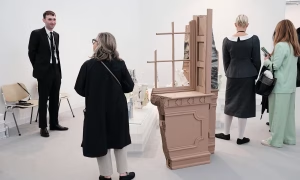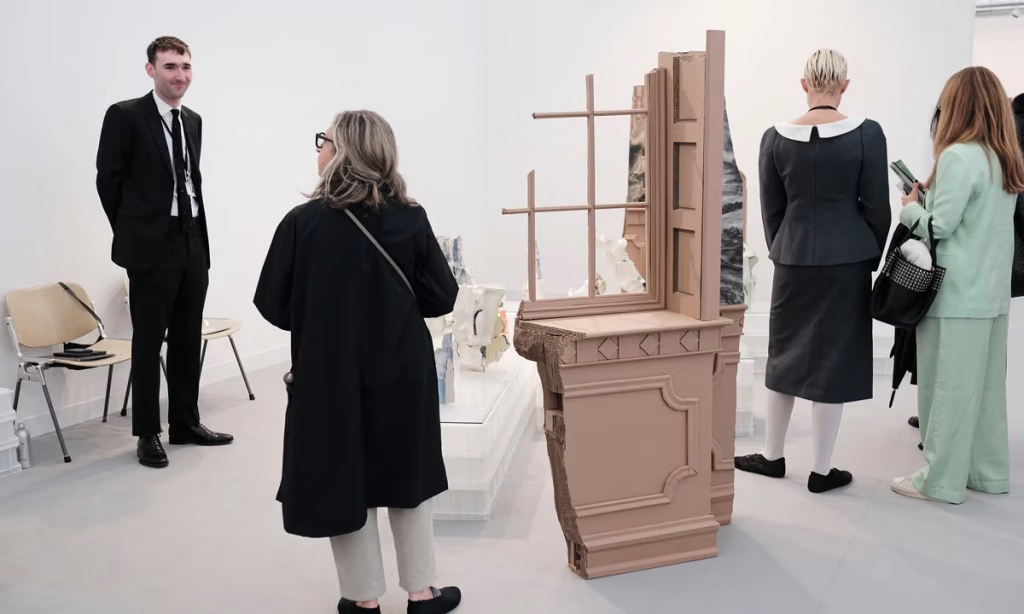October marks the 22nd edition of Frieze London, the fair powerhouse’s flagship event. Last year, organisers debuted a new floor plan that positioned emerging galleries near the main entrance and pushed blue-chip heavyweights like Gagosian, David Zwirner, Hauser & Wirth, Pace and White Cube further inside. At most commercial art fairs, top-tier galleries can pay a premium for entrance visibility. But at Frieze London in 2024, visitors had to pass through a vibrant mix of younger spaces before reaching the industry giants.
That layout is here to stay, fair director Eva Langret says, and the event’s more than 160 exhibitors will be positioned in a similar fashion this year. “The feedback from this new layout was overwhelmingly positive,” Langret says. “The audience was super excited. It enabled collectors to make new connections and discover new galleries. It’s a very simple strategy of moving everything, and now everyone has to go outside of their usual path. That re-energised the fair, so we’re sticking with it.”
The move gave a major boost to Focus, the section of Frieze London devoted to galleries under 12 years old. A new rotating system ensures that at least two stands near the entrance will change each year. This time around, where 47 Canal and Experimenter once had stands, visitors will now find Soft Opening, Portas Vilaseca and The Pit.
“The Focus section has always been a beating heart of Frieze London,” Langret says. “Compared to other major fairs, it’s a big chunk of the fair that’s dedicated to young galleries. It was very important to show that we are behind this new generation of galleries that are opening.”
New for 2025 is Echoes in the Present, a themed section curated by Jareh Das. It explores artistic links between West Africa, Brazil and their diasporas, all regions connected by the legacy of the brutal transatlantic slave trade. Around eight exhibitors will present works born from these shared histories.
Das “has brought together a group of artists across generations—from Brazil, Senegal, Angola, Nigeria and the wider African diaspora—to engage in this artistic dialogue around exchange and shared origins, trauma and history”, Langret adds.
Frieze London will kick off as the art market continues to face headwinds. This past summer saw several high-profile closures in the US, including Clearing, Blum (formerly Blum and Poe) and the Los Angeles branch of Tanya Bonakdar Gallery, all past exhibitors at Frieze London. Still, Langret remains optimistic about London’s scene; some local dealers are even expanding, including Sadie Coles HQ and Lungley Gallery.
“People are feeling optimistic about the fair. The market is in a challenging position right now, but Frieze is still successful,” she says. “It’s still a moment where everyone comes together—collectors come from all over the world, and galleries do well. The fact that they come back to do the fair year after year is really a testament to London.”
However, some dealers will not return to Frieze London this year after taking part in 2024, including Tanja Wagner, Magician Space, Tanya Leighton, Project Native Informant, Sultana, 47 Canal, Lia Rumma, Croy Nielsen and Blindspot.
Across Regent’s Park, Frieze London’s sister fair Frieze Masters will host more than 120 exhibitors from 26 countries. This year, the latter fair, which is dedicated to work from before the 20th century—sometimes going as far back as Ancient Egyptian sarcophagi—will be run by a new director, Emanuela Tarizzo.
• Frieze London and Frieze Masters, Regent’s Park, London, 15-19 October

